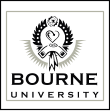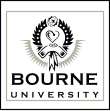© bOURNE uNIVERSITY 2021

THE BOURNE JOURNAL OF
ARCHAEOLOGY
G'NARE SKELETONS UNEARTHED IN BLACK MESA
BASIN?
Chilchinbeto l Several recent archaeological excavations in northeastern Arizona have unveiled more mysterious artifacts as several dozen giant skeletons, which scientist believe are ceremonial in nature, have been found near the Black Mesa Basin. The skeletons add to the fascinating discovery of the pyramid ruins just southwest of Chilchinbeto, where Eastern Arizona University and the Smithsonian have laid suppression of the ruin. The discovery of the skeletons lead archaeologists from Bourne University to believe that the remains may belong to the ancient city of G'nare themselves, not dating some 12,000 years ago but perhaps even much older - some several millions years, according to Joseph Claggart, Senior Professor at the Clorris School of Archaeology, Bourne University. “The complex excavations at Black Mesa has been completed by the discovery of these new skeletons near Pyramid B group which would coincide with artifacts currently revealed. These were found outside the Pyramid complex perimeter, according to the dig teams, which means these skeletons are more widespread than previously believed," said Professor Claggart. The Black Mesa site which consists of a group eight pyramid mounds of Cretaceous sedimentary rock stones meticulously tooled and fit and then wedged into deep ravines may be laid out in some ceremonial religious pattern, like Stonehenge, where astronomical observations were made much like the ancient ruins left by the Native Americans scattered over the desert edges of the Southwest. Pyramid B group is located some nine miles northwest of the main Pyramid A group. Some Bourne University archaeologists surmise the Black Mesa Basin ruins, known as G'nare, was the capital of their civilization and tomb city, which is mentioned in Oxford Professor Jebidiah E. Smith's "A Commentary on the Book of Gates" (1868). "G'nare was the City of Tombs, the God sphinxes of Gnar in rows guarded it's stone gates, There were seven beast kings who ruled their great horde, with fearsome claws and teeth, They were the root of all mammals, the seed of boars, the moose, the bear and all furred things; And stood twice the height of men-men who's bones made ornaments for their ceremony." From A Commentary on the Book of Gates (page 124). "Is this the great ruins of the tomb city that was populated by these horrible beast men Jebidiah Smith's notes tell us about? Is there any other explanation than this proving his book?" asked William Grannel, lead researcher of the Book of Gates Historical Studies, Bourne University. A Native American archaeological assistant during excavations. According to resent unsealed records from the Smithsonian Institution and released by Bourne University "Smith Studies" the ruins had been discovered in the 1970s when a mining company working with the Navajo nation on preserving sacred sites reported the find. Eastern Arizona University recognized their significance. As the ruins were on Federal lands, the Smithsonian suppressed the discovery until Bourne University forced their news nearly fifty years later.










CURRENT ISSUE

Member Since May 1922
Explore
Discover
Find
Catalog
Publish
Reward

LONDON-ROME-BERLIN-MOSCOW-NAPLES


Recent Articles
Proud Sponsor of Bourne’s Journal
Sponsored Works
News of the World





related posts
SHARE ON:
SHARE ON:


© bOURNE uNIVERSITY 2021
THE BOURNE JOURNAL OF
ARCHAEOLOGY

G'NARE SKELETONS UNEARTHED IN BLACK MESA
BASIN?
Chilchinbeto l Several recent archaeological excavations in northeastern Arizona have unveiled more mysterious artifacts as several dozen giant skeletons, which scientist believe are ceremonial in nature, have been found near the Black Mesa Basin. The skeletons add to the fascinating discovery of the pyramid ruins just southwest of Chilchinbeto, where Eastern Arizona University and the Smithsonian have laid suppression of the ruin. The discovery of the skeletons lead archaeologists from Bourne University to believe that the remains may belong to the ancient city of G'nare themselves, not dating some 12,000 years ago but perhaps even much older - some several millions years, according to Joseph Claggart, Senior Professor at the Clorris School of Archaeology, Bourne University. “The complex excavations at Black Mesa has been completed by the discovery of these new skeletons near Pyramid B group which would coincide with artifacts currently revealed. These were found outside the Pyramid complex perimeter, according to the dig teams, which means these skeletons are more widespread than previously believed," said Professor Claggart. The Black Mesa site which consists of a group eight pyramid mounds of Cretaceous sedimentary rock stones meticulously tooled and fit and then wedged into deep ravines may be laid out in some ceremonial religious pattern, like Stonehenge, where astronomical observations were made much like the ancient ruins left by the Native Americans scattered over the desert edges of the Southwest. Pyramid B group is located some nine miles northwest of the main Pyramid A group. Some Bourne University archaeologists surmise the Black Mesa Basin ruins, known as G'nare, was the capital of their civilization and tomb city, which is mentioned in Oxford Professor Jebidiah E. Smith's "A Commentary on the Book of Gates" (1868). "G'nare was the City of Tombs, the God sphinxes of Gnar in rows guarded it's stone gates, There were seven beast kings who ruled their great horde, with fearsome claws and teeth, They were the root of all mammals, the seed of boars, the moose, the bear and all furred things; And stood twice the height of men-men who's bones made ornaments for their ceremony." From A Commentary on the Book of Gates (page 124). "Is this the great ruins of the tomb city that was populated by these horrible beast men Jebidiah Smith's notes tell us about? Is there any other explanation than this proving his book?" asked William Grannel, lead researcher of the Book of Gates Historical Studies, Bourne University. A Native American archaeological assistant during excavations. According to resent unsealed records from the Smithsonian Institution and released by Bourne University "Smith Studies" the ruins had been discovered in the 1970s when a mining company working with the Navajo nation on preserving sacred sites reported the find. Eastern Arizona University recognized their significance. As the ruins were on Federal lands, the Smithsonian suppressed the discovery until Bourne University forced their news nearly fifty years later.







related posts
SHARE ON:
SHARE ON:


Recent Articles

Sponsored Works
Proud Sponsor of Bourne’s Journal





© bOURNE uNIVERSITY 2021

THE BOURNE JOURNAL OF
ARCHAEOLOGY
G'NARE SKELETONS
UNEARTHED IN BLACK MESA
BASIN?
Chilchinbeto l Several recent archaeological excavations in northeastern Arizona have unveiled more mysterious artifacts as several dozen giant skeletons, which scientist believe are ceremonial in nature, have been found near the Black Mesa Basin. The skeletons add to the fascinating discovery of the pyramid ruins just southwest of Chilchinbeto, where Eastern Arizona University and the Smithsonian have laid suppression of the ruin. The discovery of the skeletons lead archaeologists from Bourne University to believe that the remains may belong to the ancient city of G'nare themselves, not dating some 12,000 years ago but perhaps even much older - some several millions years, according to Joseph Claggart, Senior Professor at the Clorris School of Archaeology, Bourne University. “The complex excavations at Black Mesa has been completed by the discovery of these new skeletons near Pyramid B group which would coincide with artifacts currently revealed. These were found outside the Pyramid complex perimeter, according to the dig teams, which means these skeletons are more widespread than previously believed," said Professor Claggart. The Black Mesa site which consists of a group eight pyramid mounds of Cretaceous sedimentary rock stones meticulously tooled and fit and then wedged into deep ravines may be laid out in some ceremonial religious pattern, like Stonehenge, where astronomical observations were made much like the ancient ruins left by the Native Americans scattered over the desert edges of the Southwest. Pyramid B group is located some nine miles northwest of the main Pyramid A group. Some Bourne University archaeologists surmise the Black Mesa Basin ruins, known as G'nare, was the capital of their civilization and tomb city, which is mentioned in Oxford Professor Jebidiah E. Smith's "A Commentary on the Book of Gates" (1868). "G'nare was the City of Tombs, the God sphinxes of Gnar in rows guarded it's stone gates, There were seven beast kings who ruled their great horde, with fearsome claws and teeth, They were the root of all mammals, the seed of boars, the moose, the bear and all furred things; And stood twice the height of men-men who's bones made ornaments for their ceremony." From A Commentary on the Book of Gates (page 124). "Is this the great ruins of the tomb city that was populated by these horrible beast men Jebidiah Smith's notes tell us about? Is there any other explanation than this proving his book?" asked William Grannel, lead researcher of the Book of Gates Historical Studies, Bourne University. A Native American archaeological assistant during excavations. According to resent unsealed records from the Smithsonian Institution and released by Bourne University "Smith Studies" the ruins had been discovered in the 1970s when a mining company working with the Navajo nation on preserving sacred sites reported the find. Eastern Arizona University recognized their significance. As the ruins were on Federal lands, the Smithsonian suppressed the discovery until Bourne University forced their news nearly fifty years later.





SHARE ON:
SHARE ON:


Member Since May 1922
Explore
Discover
Find
Catalog
Publish
Reward

LONDON-ROME-BERLIN-MOSCOW-NAPLES



Proud Sponsor of Bourne’s Journal


Like our Sponser





